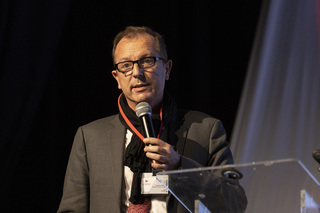UVC based decontamination of skin flora contaminated materials: a fast and complementary method to oxidant aerolization.
6 October 2021
L. Bernollin1, A. Louguet1, B. Lapras1, C. Paillet2, C. Pivot2, S. Filali1, C. Merienne1, F. Pirot11 Unité de Préparation et de Contrôle des Médicaments, plateforme FRIPHARM, Pharmacie à usage intérieur, Groupement Hospitalier Edouard Herriot - Hospices Civils de Lyon
2 Pharmacie à usage intérieur, Groupement Hospitalier Edouard Herriot - Hospices Civils de Lyon

Objectives
The production of sterile drug preparation is ideally realized by using decontaminated materials in environmental controlled areas. The decontamination of materials is frequently assured by using hydrogen peroxide/acetic acid aerolization in dedicated room followed by a transfer of decontaminated materials into ISO5-ISO8 cleanrooms. However, the duration of aerolization cycle and the time of material transfer do not permit a fast decontamination of missing material during the period of production. In the present study, we have evaluated the efficiency of UVC irradiation combined with ozone formation to decontaminate skin flora contaminated materials.
Materials and methods
A model of skin flora contaminated materials was developed by applying 55-mm contact agar plates (TSA with LT- ICR+) onto both hands of ten volunteers. Therefore, ten plates were submitted to UVC irradiation delivered by UV-box (33,5 x 25,5 x 8cm, 254 nm, 9 W) for one to ten minutes. Then irradiated and non-irradiated UVC plates were placed into 37°C incubator for seven days.
Results and discussion
As expected, non-irradiated UVC plates showed a massive growth of colony forming units (CFU, 242 ± 254) while irradiated UVC plates exhibited ≥ 2 log of reduction contamination (CFU, 4 ± 4) even after 1-min irradiation confirming the fast reduction of skin flora onto the surface of material. At the outset, we showed that UVC irradiating methods of materials dedicated for pharmaceutical production is quick, easy handle and safe method for operators, suitable for the rapid supplying by the pass-through of missing materials. This technique allows a versatile chemical residue free decontamination of a large panel of UVC compatible materials, without using disinfectant based solution inappropriate with paper wraps. However, UV-box needs performance qualification running with an efficacy assay against Staphylococcus aureus, Enterococcus hirae, Escherichia coli, Pseudomonas aeruginosa, Candida albicans and Aspergillus brasiliensis as recommended (European Pharmmacopeia 10.5, monograph 5.1.11.).
Conclusion
As reported previously for hospital room decontamination [1,2], UVC irradiation might be usefully for the decontamination of materials engaged in pharmaceutical production. UV-box provides many advantages including effectiveness, rapidity, easy and safe-handling. This equipment opens a new window for material decontamination in pharmacotechnical units.
Références: [1] Santos T dos, de Castro LF. Evaluation of a portable Ultraviolet C (UV-C) device for hospital surface decontamination. Photodiagnosis and Photodynamic Therapy. 2021 Mar;33:102161.
[2] Lindblad M, Tano E, Lindahl C, Huss F. Ultraviolet-C decontamination of a hospital room: Amount of UV light needed. Burns. 2020 Jun;46(4):842–9.